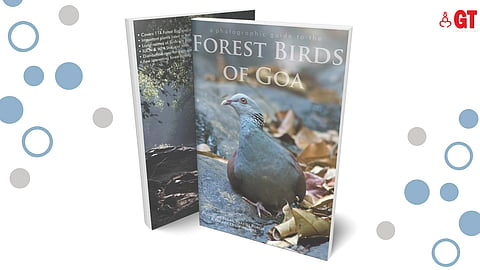

If you love the outdoors and want to explore and learn some fascinating facts about nature, then birding or bird watching is an ideal activity for you. Birds are one of the most commonly found wild species. They are all around us and always attract our attention with their songs and calls, and are full of beauty.
In a coastal state like Goa, studying wetlands birds (birds found near water bodies) is a highly sought-after activity.
However, there’s another category of birds — forest birds. Studying these birds is not easy as they are little difficult to spot, identify, etc. But now, with the recent release of the book, A photographic guide to the Forest Birds of Goa, that task has become easier.
This book has been authored by Prasanna Parab and co-authored by Paresh Porob (who works with Goa Forest Department) and naturalist Omkar Dharwadkar.
The foreword is by ornithologist and editor of the journal, Indian Birds, Aasheesh Pittie, and describes this book as a valuable addition to the avian literature of the state.
WHAT’S INSIDE
Prasanna Parab who is one of the founder members of the GBCN (Goa Bird Conservation Network) states that this work is based on his research of 15 years. He specialises in forest birds of Goa.
The book lists 114 species of forest birds, which are resident and migratory.
The book has some excellent images of the birds along with information, ranging from latest taxonomy to its status, distribution, habitat and behaviour, along with a distribution map.
The habitats which the book has covered are — the foothills of the Western Ghats, central hills and forests adjoining the plateaus upto the coast.
The book also features birds which were not documented before in Goa like Wayanad Laughing Thrush, White-Bellied Treepie, Large Hawk Cuckoo and Sri Lanka Bay Owl.
It includes a list of birds which are endemic to the Western Ghats like the Grey-Fronted Green Pigeon, Flame-Throated Bulbul (state bird of Goa), Malabar Grey Hornbill, to name a few out of 15 species listed in the book.
Another list is that of birds which are globally threatened or endangered — like the Nilgiri Wood Pigeon (the bird on the book cover), Great Hornbill, Lesser Fish-Eagle, Grey Headed Bulbul, out of eight species. Many of the endemic species are also threatened.
Even though these birds are found in protected forests of Goa, there is a looming threat to their habitat as a whole.
Prasanna states, “The habitat is under threat due to the human factor like demand for land, change in land use, etc.”
He points out that sometimes we may find a group of birds on a hillock which were not seen otherwise. It could be because of habitat destruction and not increase in bird population.
“Thinking that it is increase in bird population is a wrong assumption as it is the island kind of effect and that itself can be a huge threat.”
He explained that studying forest birds is always tricky compared to wetland birds.
“Forest birds are very shy and it is difficult to assess the total number of species compared to wetland birds. You may come across 10 birds of the same species, but it could be just 2 birds or even 100.”
MORE THAN BIRD SPECIES
These 114 species of birds which are listed in this book are those that are totally dependent on forest habitat. For example, the Great Hornbill will look out for only evergreen tree species, which are 30 meters high, to make their nests. These are basically canopy trees and found in deep forests.
Prasanna shares that in a forest, even a dead tree is used by birds to make nests or to live in the holes of such trees. He elaborates that evergreen and semi-evergreen forests are very important. Thus, the book has listed even the trees or plants which are used and frequented by the birds.
It states the botanical, common and even local names of the trees. This is a very important addition as it will help in understanding the whole habitat rather than just birds.
Goa, as we know, is home to five wildlife sanctuaries and one national park. Thus, it gives immense scope to study such birds. Prasanna elaborates that out of all these places, Cotigao forests are one of the richest in terms of bird diversity, followed by Mollem and Netravali.
“The advantage that Cotigao has is that its core areas have few villages, and the villagers live in harmony with nature,” says he.
When asked what the most challenging aspect of the book was, Prasanna informed that it was collecting data about the local names of the birds. Many a time, there may be generic names for more than one species of birds or there are different names in different parts of Goa, for the same species. Thus, they worked with local experts, villagers, to streamline all these names.
This is probably the first time that readers will get a chance to learn all the local names of the birds. It is an ideal book for serious birders, students and enthusiasts who want to study such habitats.
For Prasanna, who works with the Department of Posts, birding is his passion and he is dedicated to studying forests. Currently, he is also documenting freshwater fish and spiders.
The book is available online on Amazon India and also on Prasanna Parab’s website https://www.intowilderness.in/publications
Arti Das is a freelance journalist based in Goa. She loves writing about art, culture and the ecology of Goa.